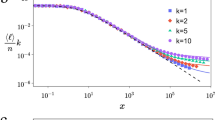Abstract
The minimization of Fisher’s information (MFI) approach of Frieden et al. [Phys. Rev. E 60, 48 (1999)] is applied to the study of size distributions in social groups on the basis of a recently established analogy between scale invariant systems and classical gases [Phys. A 389, 490 (2010)]. Going beyond the ideal gas scenario is seen to be tantamount to simulating the interactions taking place, for a competitive cluster growth process, in a scale-free ideal network – a non-correlated network with a connection-degree’s distribution that mimics the scale-free ideal gas density distribution. We use a scaling rule that allows one to classify the final cluster-size distributions using only one parameter that we call the competitiveness, which can be seen as a measure of the strength of the interactions. We find that both empirical city-size distributions and electoral results can be thus reproduced and classified according to this competitiveness-parameter, that also allow us to infer the maximum number of stable social relationships that one person can maintain, known as the Dunbar number, together with its standard deviation. We discuss the importance of this number in connection with the empirical phenomenon known as “six-degrees of separation”. Finally, we show that scaled city-size distributions of large countries follow, in general, the same universal distribution.
Similar content being viewed by others
References
M. Batty, Science 319, 769 (2008)
A. Blank, S. Solomon, Physica A 287, 279 (2000)
X. Gabaix, Y.M. Ioannides, Handbook of Regional and Urban Economics (North-Holland, Amsterdam, 2004), Vol. 4
W.J. Reed, J. Reg. Sci. 42, 1 (2002)
M.E.J. Newman, Contemp. Phys. 46, 323 (2005)
V. Pareto, Cours d`Economie Politique (Droz, Geneva, 1896)
G.K. Zipf, Human Behavior and the Principle of Least Effort (Addison-Wesley, Cambridge, MA, 1949)
L.C. Malacarne, R.S. Mendes, E.K. Lenzi, Phys. Rev. E 65, 017106 (2001)
M. Marsili, Y.-C. Zhang, Phys. Rev. Lett. 80, 2741 (1998)
R.L. Axtell, Science 293, 1818 (2001)
K. Paech, W. Bauer, S. Pratt, Phys. Rev. C 76, 054603 (2007)
X. Campi, H. Krivine, Phys. Rev. C 72, 057602 (2005)
Y.G. Ma et al., Phys. Rev. C 71, 054606 (2005)
C. Furusawa, K. Kaneko, Phys. Rev. Lett. 90, 088102 (2003)
I. Kanter, D.A. Kessler, Phys. Rev. Lett. 74, 4559 (1995)
M.E.J. Newman, Phys. Rev. E 64, 016131 (2001)
A. Hernando, D. Puigdomènech, D. Villuendas, C. Vesperinas, A. Plastino, Phys. Lett. A 374, 18 (2009)
R. Albert, A.L. Barabási, Rev. Mod. Phys. 2074, 2047 (2002)
M.E.J. Newman, A.L. Barabasi, D.J. Watts, The Structure and Dynamics of Complex Networks (Princeton University Press, Princeton, 2006)
T. Maillart, D. Sornette, S. Spaeth, G. von Krogh, Phys. Rev. Lett. 101, 218701 (2008)
R.N. Costa Filho, M.P. Almeida, J.S. Andrade, J.E. Moreira, Phys. Rev. E 60, 1067 (1999)
A. Hernando, C. Vesperinas, A. Plastino, Phys. A 389, 490 (2010)
R. Frieden, A. Plastino, A.R. Plastino, B.H. Soffer, Phys. Rev. E 60, 48 (1999)
UrbanSim: http://www.urbansim.org, SLEUTH: http://www.ncgia.ucsb.edu/projects/gig/, DUEM: http://www.casa.ucl.ac.uk/software/duem.asp
C. Castellano, S. Fortunato, V. Loreto, Rev. Mod. Phys. 81, 591 (2009)
S. Fortunato, C. Castellano, Phys. Rev. Lett. 99, 138701 (2007)
M. Batty, Cities and Complexity: Understanding Cities Through Cellular Automata, Agent-Based Models, and Fractals (MIT Press, Cambridge, MA, 2005)
H. Gould, J. Tobochnik, An Introduction to Computer Simulation Methods: Applications to Physical Systems, 2nd edn. (Addison-Wesley, 1996)
W.J. Reed, B.D. Hughes, Phys. Rev. E. 66, 067103 (2002)
R. Albert, H. Jeong, A.L. Barabási, Nature 401, 130 (1999)
R. Guimerà, R.L. Danon, A. Díaz-Guilera, F. Giralt, A. Arenas, Phys. Rev. E 68, 065103(R) (2003)
J. Leskovec, E. Horvitz (2008), e-print arXiv:0803.0939v1
K. Christensen, H. Flyvbjerg, Z. Olami, Phys. Rev. Lett. 71, 2737 (1993)
A. Mezhlumian, S.A. Molchanov, J. Stat. Phys. 71, 799 (1993)
S. Zapperi, K.B. Lauritsen, H.E. Stanley, Phys. Rev. Lett. 75, 4071 (1995)
A.A. Moreira, D.R. Paula, R.N.C. Filho, J.S. Andrade, Phys. Rev. E 73, 065101(R) (2006)
M. Molloy, B. Reed, Random Struct. Algorithms 6, 161 (1995)
M.E.J. Newman, S.H. Strogatz, D.J. Watts, Phys. Rev. E 64, 026118 (2001)
B.R. Frieden, B.H. Soffer, Phys. Rev. E 52, 2274 (1995)
B.R. Frieden, Physics from Fisher Information, 2nd edn. (Cambridge Univ. Press, Cambridge, 1998)
B.R. Frieden, Science from Fisher Information (Cambridge Univ. Press, Cambridge, 2004)
M. Batty, Nature 444, 592 (2006)
R. Toral, C.J. Tessone, Commun. Comput. Phys. 2, 177 (2007)
A. Clauset, C.R. Shalizi, M.E.J. Newman (2009), e-print arXiv:0706.1062v2
National Statistics Institute of Spain website, Government of Spain, (www.ine.es)
L. Valitova, V. Tambovtsev, Regional policy priorities in Russia: empirical evidence, RECEP Reports (2005), Vol. 5, p. 9
M. Gladwell, The Tipping Point – How Little Things Make a Big Difference (Little, Brown and Company, 2000)
R.I.M. Dunbar, J. Hum. Evo. 20, 469 (1992)
R.I.M. Dunbar, Beh. Brain Sci. 16, 681 (1993)
Census bureau website, Government of USA, www.census.gov
J. Travers, S. Milgram, Sociometry 32, 425 (1969)
D.J. Watts, Six Degrees: The Science of a Connected Age (Norton, New York, 2003)
D.J. Watts, Small Worlds: The Dynamics of Networks Between Order and Randomness (Princeton University Press, Princeton, 1999)
P.S. Dodds, R. Muhamad, D.J. Watts, Science 301, 827 (2003)
Electoral Commission, Government of UK, http://www.electoralcommission.org.uk
National Archives and Records Administration, Government of USA. www.archives.gov
Ministero dell’Interno – Elezioni Politiche, Government of Italy. politiche.interno.it
Ministerio del Interior, Elecciones, Government of Spain. www.elecciones.mir.es
UK Statistics Authority, www.statistics.gov.uk
Wolfram Mathematica CityData Source, based on a wide range of sources. www.wolfram.com
Author information
Authors and Affiliations
Corresponding authors
Rights and permissions
About this article
Cite this article
Hernando, A., Villuendas, D., Vesperinas, C. et al. Unravelling the size distribution of social groups with information theory in complex networks. Eur. Phys. J. B 76, 87–97 (2010). https://doi.org/10.1140/epjb/e2010-00216-1
Received:
Revised:
Published:
Issue Date:
DOI: https://doi.org/10.1140/epjb/e2010-00216-1




